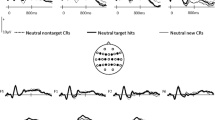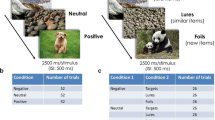Abstract
A suggestive hypothesis proposed that the lateral prefrontal cortex (LPFC) may be identified as the site of emotion-memory integration, since it was shown to be sensitive to the encoding and retrieval of emotional content. In the present research we explored the role of the dorsolateral prefrontal cortex (DLPFC) in memory retrieval of positive vs. negative emotional stimuli. This effect was analyzed by using an rTMS paradigm that induced a cortical activation of the left DLPFC. Subjects were required to perform a task consisting of two experimental phases: an encoding phase, where some lists composed by positive and negative emotional words were presented to the subjects; a retrieval phase, where the old stimuli and the new stimuli were presented for a recognition performance. The rTMS stimulation was provided during the retrieval phase over the left DLPFC. We found that the rTMS stimulation over this area affects the memory retrieval of positive emotional material, with higher memory efficiency (reduced RTs). This result suggested that left DLPFC activation promotes the memory retrieval of emotional information. Secondly, the valence model of emotional cue processing may explain decreasing of RTs, by pointing out the distinct role the left hemisphere has in positive emotional cue processing.




Similar content being viewed by others
References
Balconi, M., & Caldiroli, C. (2011). Semantic violation effect on object-related action comprehension. N400-like event-related potentials for unusual and incorrect use. Neuroscience, 197, 191–199.
Balconi, M., & Lucchiari, C. (2005). In the face of emotions: Event-Related Potentials in supraliminal and subliminal facial expression recognition. Genetic, Social and General Psychology, 131, 41–69.
Balconi, M., & Mazza, G. (2010). Lateralisation effect in comprehension of emotional facial expression: a comparison between EEG alpha band power and behavioural inhibition (BIS) and activation (BAS) systems. Laterality: Asymmetries of Body, Brain and Cognition, 15, 361–384.
Balconi, M., & Pozzoli, U. (2007). Event-related oscillations (EROs) and event-related potentials (ERPs) comparison in facial expression recognition. Journal of Neuropsychology, 1, 183–294.
Balconi, M., Brambilla, E., & Falbo, L. (2009). BIS/BAS, cortical oscillations and coherence in response to emotional cues. Brain Research Bulletin, 80, 151–158.
Balconi, M., Ferrari, C., & Amenta, S. (2010). Dorsolateral Prefrontal Cortex involvement in recognitionm. An rTMS study on stress-related words. Neuropsychological Trends, 8, 100–103.
Beck, A.T., Ward, C.H., Mendelson, M., Mock, J., & Erbaugh, J. (1961). An inventory for measuring depression. Arch. Gen. Psychiatry 4, 561–571.
d’Alfonso, A. A., van Honk, J., Hermans, E., Postma, A., & de Haan, E. H. (2000). Laterality effects in selective attention to threat after repetitive transcranial magnetic stimulation at the prefrontal cortex in female subjects. Neuroscience Letters, 280, 195–198.
Davachi, L., Maril, A., & Wagner, A. D. (2001). When keeping in mind supports later bringing to mind: neural markers of phonological rehearsal predict subsequent remembering. Journal of Cognitive Neuroscience, 13, 1059–1070.
Davidson, R. J. (1995). Cerebral asymmetry, emotion and affective style. In R. J. H. Davidson & K. Hugdahl (Eds.), Brain asymmetry (pp. 361–387). Cambridge: MIT.
Davidson, R., & Irwin, W. (1999). The functional neuroanatomy of emotion and affective style. Trends in Cognitive Sciences, 3, 11–21.
Davidson, R. J., Abercrombie, H., Nitschke, J. B., & Putnam, K. (1999). Regional brain function, emotion and disorders of emotion. Current Opinion in Neurobiology, 9, 228–234.
Davis, M. (1992). The role of the amygdala in fear and anxiety. Annual Review of Neuroscience, 15, 353–428.
Dolcos, F., LaBar, K. S., & Cabeza, R. (2004). Interaction between the amygdala and the medial temporal lobe memory system predicts better memory for emotional events brain sites sensitive to amygdalar modulatory influences. Neuron, 42, 855–863.
Donald, G. M., Shafto, M., Taylor, J. K., Marian, D. E., Abrams, L., & Dyer, J. R. (2004). Relations between emotion, memory, and attention: evidence from taboo Stroop, lexical decision, and immediate memory tasks. Memory & Cognition, 32, 474–488.
Eysenck, M. W., & Calvo, M. G. (1992). Anxiety and performance: the processing efficiency theory. Cognition and Emotion, 6, 409–434.
Eysenck, M., Payne, S., & Derakshan, N. (2005). Trait anxiety, visuospatial processing, and working memory. Cognition & Emotion, 19, 1214–1228.
George, M., Wassermann, E., Kimbrell, T., Little, J., Williams, W., Danielson, A., et al. (1997). Mood improvement following daily left prefrontal repetitive transcranial magnetic stimulation in patients with depression: a placebo-controlled crossover trial. American Journal of Psychiatry, 154, 1752–1756.
Gray, J. R., Braver, T. S., & Raichle, M. E. (2002). Integration of emotion and cognition in the lateral prefrontal cortex. Proceedings of the National Academy of Science, 99, 4115–4120.
Hariri, A., Bookheimer, S., & Mazziotta, J. (2000). Modulating emotional responses: effects of a neocortical network on the limbic system. Neuroreport, 11, 43–48.
Heller, W., & Nitschke, J. B. (1998). The puzzle of regional brain activity in depression and anxiety: the importance of subtypes and comorbidity. Illinois Research, 12, 421–447.
Jaspers, H. H. (1958). The ten–twenty electrode system of the International Federation. Electroencephalography and Clinical Neurophysiology, 10, 367–380.
Kalish, Y., & Robins, G. (2006). Psychological predispositions and network structure: the relationship between individual predispositions, structural holes and network closure. Social Networks, 28, 56–84.
Kimbrell, T. A., Little, J. T., Dunn, R. T., Frye, M. A., Greenberg, B. D., Wassermann, E. M., et al. (1999). Frequency dependence of antidepressant response to left prefrontal repetitive transcranial magnetic stimulation (rTMS) as a function of baseline cerebral glucose metabolism. Biological Psychiatry, 46, 1603–1613.
Knight, R. T., Staines, W. R., Swick, D., & Chao, L. L. (1999). Prefrontal cortex regulates inhibition and excitation in distributed neural networks. Acta Psychologica, 101, 159–178.
Ledoux, J. E., Romanski, M., & Xagoraris, A. (1990). The lateral amygdaloid in fear conditioning nucleus: sensory interface amygdala. The Journal of Neuroscience, 10, 1062–1069.
Manenti, R., Cotelli, M., Calabria, M., Maioli, C., & Miniussi, C. (2010). The role of the dorsolateral prefrontal cortex in retrieval from long-term memory depends on strategies: a repetitive transcranial magnetic stimulation study. Neuroscience, 166, 501–508.
Mikles, J. A., Reuter-Lorenz, P. A., Beyer, J. A., & Fredrickson, B. L. (2008). Emotion and working memory: evidence for domain-specific processes for affective maintenance. Emotion, 8, 256–266.
Miller, E. K., & Cohen, D. J. (2001). An integrative Theory of prefrontal cortex function. Annual Review of Neuroscience, 24, 167–202.
Miniussi, C., Cappa, S. F., Cohen, L. G., Floel, A., Fregni, F., Nitsche, M., et al. (2008). Efficacy of repetitive transcranial magnetic stimulation/transcranial direct current stimulation in cognitive neurorehabilitation. Brain Stimulation, 1, 326–36.
Miniussi, C., Ruzzoli, M., & Walsh, V. (2010). The mechanism of transcranial magnetic stimulation in cognition. Cortex, 46, 128–130.
Petersen, S. E., van Mier, H., Fiezi, J. A., & Raichle, M. E. (1998). The effects of practice on the functional anatomy of task performance. Proceedings of the National Academy of Sciences, 95, 853–860.
Reuter-Lorenz, P. A., Givis, R. P., & Moscovitch, M. (1983). Hemispheric specialization and the perception of emotion: evidence from right-handers and from inverted and noninverted left-handers. Neuropsychologia, 21, 687–692.
Rossi, S., Hallett, M., Rossini, P. M., & Pascual-Leone, A. (2009). The Safety of TMS Consensus Group, Safety, ethical considerations, and application guidelines for the use of transcranial magnetic stimulation in clinical practice and research. Clinical Neurophysiology, 120, 2008–2039.
Rossini, P. M., Barker, A. T., Berardelli, A., Caramia, M. D., Caruso, G., Cracco, R. Q., et al. (1994). Non-invasive electrical and magnetic stimulation of the brain, spinal cord and roots: basic principles and procedures for routine clinical application. Report of an IFCN committee. Electroencephalography and Clinical Neurophysiology, 91, 79–92.
Sandrini, M., Cappa, S. F., Rossi, S., Rossini, P. M., & Miniussi, C. (2003). The role of prefrontal cortex in verbal episodic memory: rTMS evidence. Journal of Cognitive Neuroscience, 15, 855–916.
Schutter, D., van Honk, J., d’Alfonso, A., Postma, A., & de Haan, E. (2001). Effects of slow rTMS at the right dorsolateral prefrontal cortex on EEG asymmetry and mood. Neuroreport, 12, 445–447.
Shimamura, A. P. (2000). The role of the prefrontal cortex in dynamic filtering. Psychobiology, 28, 207–218.
Talairach, J., & Tournoux, P. (1988). Co-planar stereotaxic atlas of the human brain 3-Dimensional Proportional System: An approach to cerebral imaging. New York: Stuttgart.
van Honk, J., Tuiten, A., Verbaten, R., van den Hout, M., Koppeschaar, H., Thijssen, J., et al. (1999). Correlations among salivary testosterone, mood, and selective attention to threat in humans. Hormones and Behavior, 36, 17–24.
Wassermann, E. M., Wedegaertner, F. R., Ziemann, U., George, M. S., & Chen, R. (1998). Crossed reduction of human motor cortex excitability by 1-Hz transcranial magnetic stimulation. Neuroscience Letters, 250, 141–144.
Author information
Authors and Affiliations
Corresponding author
Rights and permissions
About this article
Cite this article
Balconi, M., Ferrari, C. Emotional memory retrieval. rTMS stimulation on left DLPFC increases the positive memories. Brain Imaging and Behavior 6, 454–461 (2012). https://doi.org/10.1007/s11682-012-9163-6
Published:
Issue Date:
DOI: https://doi.org/10.1007/s11682-012-9163-6




